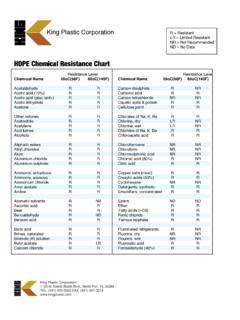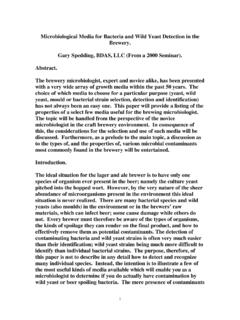Transcription of SUCROSE MONOESTERS OF LAURIC, PALMITIC OR …
1 Page 1 of 11 SUCROSE MONOESTERS OF lauric , PALMITIC OR STEARIC acid Chemical and Technical Assessment Prepared by Yoko Kawamura, PhD, and reviewed by Mrs Inge Meyland 1. Summary SUCROSE MONOESTERS of lauric , PALMITIC or stearic acid consist mainly of SUCROSE MONOESTERS of individual fatty acids, namely lauric , PALMITIC or stearic acid with smaller amounts of the di-esters. They are manufactured by a transesterification reaction of SUCROSE and vinyl esters of the subject fatty acids. The reaction conditions limit the products primarily to the monoester compounds. Potential trace impurities are removed by a series of distillation and solvent extraction steps.
2 These products have a high emulsifying capacity and thus are used in beverage applications as emulsifiers at low concentrations. The Committee established a group ADI of 0-30 mg/kg bw for SUCROSE MONOESTERS of lauric , PALMITIC or stearic acid together with SUCROSE esters of fatty acids, sucroglycerides, SUCROSE oligoesters type I and SUCROSE oligoesters type II and the new tentative specifications were prepared at the 73rd JECFA (2010). The specifications were revised and the tentative status was removed at the 74th JECFA (2011). 2. Description SUCROSE MONOESTERS of lauric , PALMITIC or stearic acid consist mainly MONOESTERS of lauric , PALMITIC or stearic acid with smaller amounts of its diesters.
3 They appear white to off white powder. They have a high hydrophobic hydrophilic balance (HLB) value that gives them a high emulsifier efficacy. The SUCROSE MONOESTERS of lauric acid , PALMITIC acid or stearic acid have excellent emulsifying properties and are used at low levels to emulsify flavours, colours and nutraceutical ingredients ( , omega-3 oils) to produce a number of clear beverage products. They are manufactured by a transesterification reaction between SUCROSE and vinyl esters of the following specific fatty acids: lauric acid , PALMITIC acid or stearic acid . This manufacturing process is different from the processes for SUCROSE esters of fatty acids.
4 As a consequence of the manufacturing process, several trace impurities may be found in the final purified products. These include vinyl laurate, vinyl palmitate or vinyl stearate as starting materials, acetaldehyde formed by tautomerization of vinyl alcohol released in the transesterification reaction, and p-methoxyphenol that is added in vinyl palmitate and vinyl stearate as a stabilizer. Page 2 of 11 3. Manufacturing Outline of the manufacturing process for SUCROSE MONOESTERS of lauric , PALMITIC or stearic acid is shown on Figure 1. Figure 1. Outline of Manufacturing Process for SUCROSE MONOESTERS of lauric , PALMITIC or stearic acid Stir for specified time period Reaction Stir and heat to specified conditions Mix DMSO and SUCROSE Add vinyl fatty acid esterAdd soda ash (catalyst)
5 React for specified time period Add lactic acid Neutralization Evaporate the majority of DMSO through vacuum distillation at specified pressure Distillation I Dissolve the solid distillation residue in salt water Add isobutanol at same volume with salt water/solids mixture Remove aqueous layer and discard it Mix and allow to settle Liquid-Liquid Extraction Page 3 of 11 The basic raw materials for manufacturing SUCROSE MONOESTERS of lauric , PALMITIC and stearic acid preparations are high purity SUCROSE (> ) and high purity vinyl fatty acid esters of lauric acid (99%), stearic acid (95%) or PALMITIC acid (95%). The transesterification reaction takes place in dimethylsulfoxide via the addition of sodium carbonate and the reaction is stopped by the addition of lactic acid to neutralize the reaction mixture.
6 The ratio of mono to di-esters is controlled by the ratio of SUCROSE to vinyl fatty acid ester. The time of the reaction is in the order of minutes. Following reaction, the product go through a series of purification steps to remove impurities and residual solvents. Add salt water at 1:1 to the solvent layer Evaporate iso-butanol from the feed mixture Dissolve the post-distillation residue in water Remove the remaining contaminants by ultra-filtration Freeze dry Pack the product into hermetically sealed containers Mix and let allow to settle for specified time period Drain aqueous layer and discard Liquid-Liquid Extraction (continued) Distillation II Membrane Filtration Packing Drying Page 4 of 11 The DMSO is removed in series of distillation and extraction steps.
7 To remove the excess of SUCROSE , sodium carbonate and lactic acid , the resulting solid is dissolved in salt water with 10% isobutanol and extracted with isobutanol (1:1 v/v of water). The aqueous layer is discarded and the solvent layer extracted again with an equal volume of salt solution and the aqueous layer is discarded. The isobutanol is removed by evaporation and the solid product is dissolved in water (5% w/v). The solution is filtered and the remaining impurities are then removed by ultra-filtration. This solution is concentrated to 25% solids content and then freeze dried. The solid product is milled and packaged in hermetically sealed containers.
8 4. Chemical Characterization Tables 1-3 show analytical data mainly according to the specifications for SUCROSE esters of fatty acids in several different manufacturing lots of final products, SUCROSE MONOESTERS of lauric , PALMITIC or stearic acid . Table 1. Result of Chemical Analysis for SUCROSE Monolaurate Manufacturing Lots Specification Parameter Specification Manufacturing Lots MT09L001 MT10A001 MTA10002 Assay (%) > 80 Monoester content (% ot total esters) - Diester content (% ot total esters) - Fatty acid Positive Positive Positive Positive Sugars Positive Positive Positive Positive acid value < 6 Free SUCROSE (%) < 5 Sulfated ash (%) < 2 Arsenic (mg/kg)
9 <2 <2 <2 <2 Lead (mg/kg) <2 <2 <2 <2 Dimethylsulfoxide (mg/kg) < 2 <2 <2 <2 Isobutanol (mg/kg) <10 <10 <10 <10 Page 5 of 11 Table 2. Results of Chemical Analysis for SUCROSE Monopalmitate Manufacturing Lots Specification Parameter Specification Manufacturing Lots SII09F013 SII09F014 SII09G002 SII09G003 SII09G004 Assay (%) > 80 Monoester content (% of total esters) - Diester content (% of total esters) - Fatty acid Positive Positive Positive Positive Positive Positive Sugars Positive Positive Positive Positive Positive Positive acid value < 6 Free SUCROSE (%) < 5 Sulfated ash (%) < 2 Arsenic (mg/kg) < <2 <2 <2 <2 <2 Lead (mg/kg)
10 <2 <2 <2 <2 <2 <2 Dimethylsulfoxide (mg/kg) < 2 <2 <2 <2 <2 <2 Isobutanol (mg/kg) <10 <10 <10 <10 <10 <10 Table 3. Results of Chemical Analysis for SUCROSE Monostearate Manufacturing Lots Specification Parameter Specification Manufacturing Lots MT10A003 MT10A004 MT10A005 Assay (%) > 80 Monoester content (% of total esters)) - Dister content (% of total esters))


















